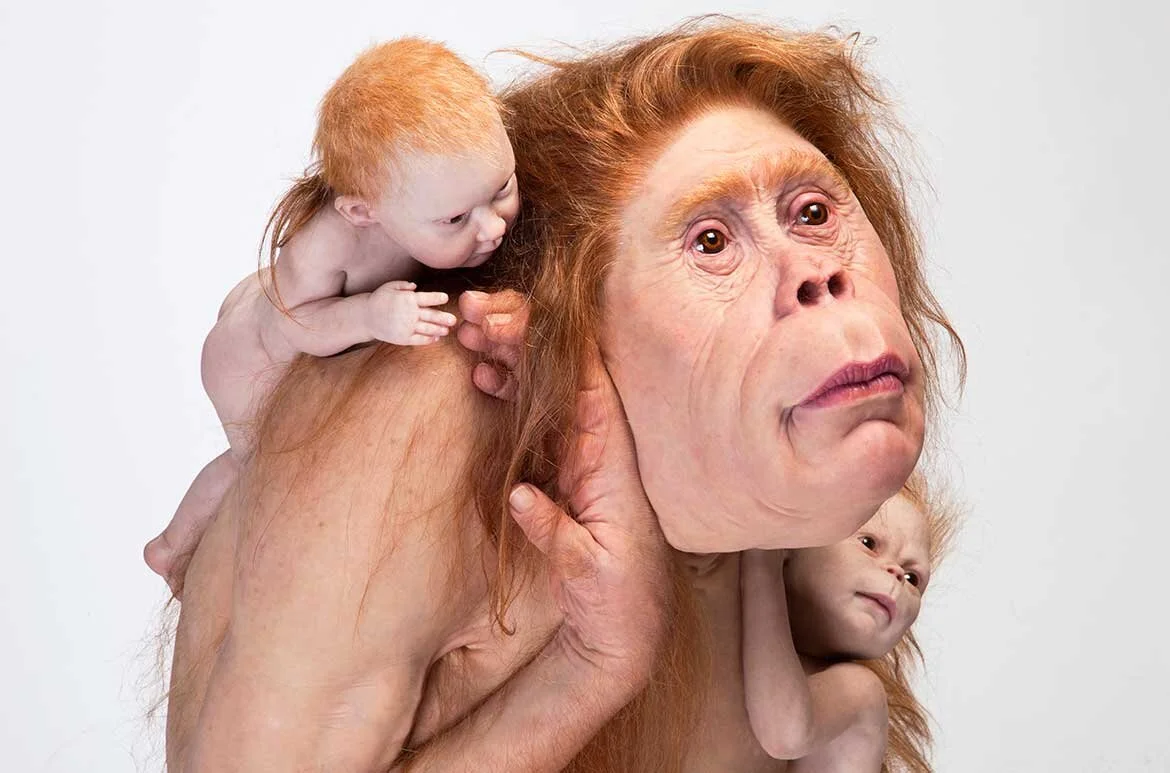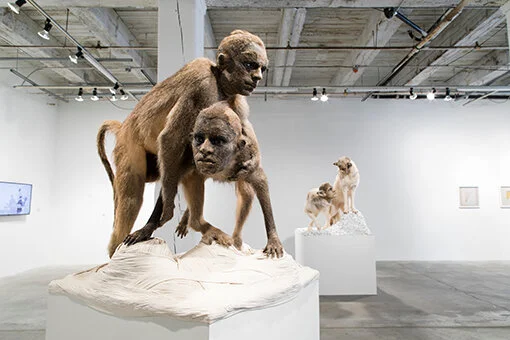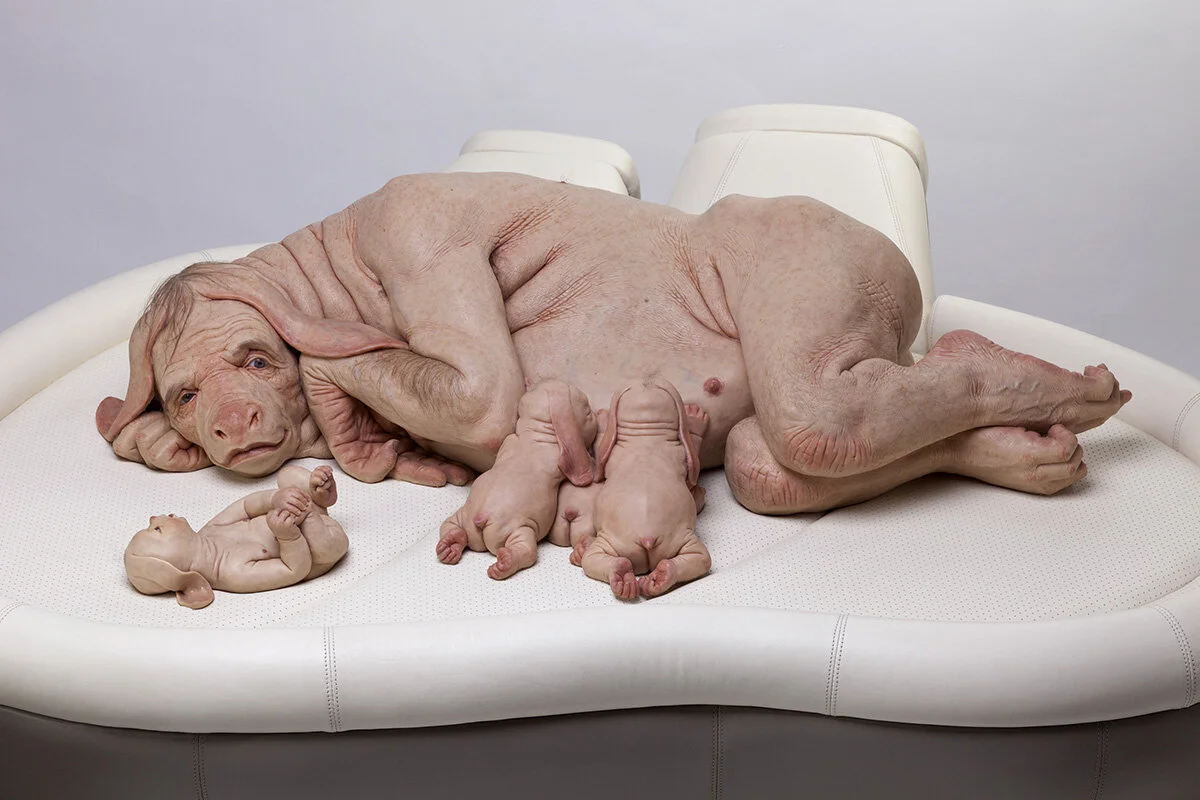Why is art the place to imagine chimeras and human-animal hybrids?
What does it mean to alter nature’s evolution? What is humanness if we can customize people with animal features? How will our relationships with animals and plants change if new inter-species are created?
Speculative contemporary art is a creative space to express socio-political problems, explore possibilities and imagine futures. Like science fiction, artworks sometimes even predict what might happen before it does, and certainly confront us with our hopes and fears for tomorrow.
Kindred by Patricia Piccinini, 2018, silicone, fibreglass, hair (103 x 95 x 128cm) (c) The artist
What’s a chimera?
A genetic chimera is an organism with the material from two or more sources. Scientists argue that chimeras could be used to solve medical problems to save lives. Crispr researchers suggest that by growing human organs with the recipient’s cells in animals, they can be transplanted into people who need organ transplants. Scientists are also using animal hybrids to investigate new ways to treat cancer.
In Greek mythology, a chimera was a mythical creature composed of the parts of more than one animal. You might be familiar with a centaur that is half human half horse, or a griffin with the body of a lion and wings of an eagle. Chimeras are present in many religions such as Vishnu, a Hindu human-animal God.
When it comes to bioengineering, research is accelerating so fast that the laws can’t keep up with the changes. Did you know that human-animal hybrid embryos have already been created? Scientists announced human-monkey embryos in August 2019. Already human cells were introduced into mice embryos in March 2019 and pig embryos in 2017. On the margins of ethical controversy, we dive into the artwork that imagines chimeras of the future.
Take a look at six artists that use bioengineering and organic materials to explore the theme of chimeras.
Hybrid organs by Agi Haines
Bio designer Agi Haines’s Circumventive Organs proposes 3D printing the living tissue of organs. The concept is that implanting biologically enhanced organs using cells from animals could fix human disorders. Could the cells of leeches be used in organs to perform tasks like thinning blood? Or could the genetic makeup of an electric eel kick-start the heart? Printing new-improved organs would speed up what ‘would take millions of years to evolve naturally’, she said. Who wouldn’t want to accelerate natural evolution? Why not use the genetic ability to improve the human body?
Circumventive Organs by Agi Haines, 2013, (c) The artist
Transgenic experiments by Eduardo Kac
Known for his transgenic art, Eduardo Kac is a household name in the Bioart world. In 2000, he collaborated with the French geneticist Louis-Marie Houdebine to use DNA to create ‘new species’. A living rabbit called Alba was genetically modified using the bioluminescent GFP gene of a jellyfish. This glow-in-the-dark living rabbit artwork was forbidden to be exhibited, yet he was applauded for drawing attention to genetic research at the time. Interestingly, scientists created glowing rabbits in an experiment thirteen years later in 2013.
“It kind of turns the searchlights back on scientists. There are some pretty awfully deformed animals in transgenic research, and scientists have sometimes done these things with no good theory behind it.”
Alba by Eduardo Kac, 2000
Taxidermy Chimeras by Kate Clark
Brooklyn-based artist Kate Clark transposes human facial features onto taxidermied animal bodies. Clark’s sculptures embody how human characteristics are projected onto animals, and suggests how humans are more like animals than we like to think. The couples of animals create a dynamic aspect of relationships. What if the genetic developments could give human genes to animals?
Rivalry by Kate Clark, 2012, baboon hide, foam, clay, pins, thread, rubber eyes, rope, (82 x 36 x 36 inches) (c) Colin Conces, for Bemis Centre for Contemporary Arts
Bully by Kate Clarke, 2010, wolf hide, clay, foam, thread, pins, rubber eyes, wood, paint (82 x 42 x 54 inches) (c) Colin Conces, for Bemis Centre for Contemporary Arts
Hyperreal sculptures by Patricia Piccinini
An artist fascinated by the changing nature of the human body is Patricia Piccinini. She creates satirical imaginings of Darwinism, with hyperrealist sculptures of animal hybrids creatures made with silicone, fibreglass and hair. The static beings play on our pathos because the anthropomorphic sculptures look lifelike, with human-like expressions and interactions. The skin folds, veins and hairs of her imaginary hybrids are unbelievably realistic, giving us a sense of the uncanny as to whether they will suddenly move with life.
The Young Family by Patricia Piccinini, 2018, silicone, fibreglass, hair (103 x 95 x 128cm) (c) The artist
Human-rats by Kathy High
Kathy High’s Embracing Animal is an artwork installation reflecting on the human-animal relationship with lab rats. In this mixed media installation, living rats that have been micro-injected with human DNA could be used as tools to research autoimmune disease. She highlights the changing relationships with animals if they could represent a part of our genes.
Embracing Animal by Kathy High, 2004-6. Site-specific, mixed media installation with glass tubes, video, sound, live transgenic laboratory rats in extended rat habitat, computer terminal with website. (c) The artist
Inter-species babies by Ai Hasegawa
In the future, when we’re in a crisis of food shortages and overpopulation, artist Ai Hasegawa created a solution: Humans can give birth to their food. In the video I Wanna Deliver a Dolphin, the artist imagined that women could gestate and give birth to a baby from another species, in this case a dolphin, before eating it. If we nurture our food as a baby, will it encourage us to eat less meat?
I Wanna Deliver a Dolphin by Ai Hasegawa, 2013 (c) The artist
Why art?
We are in an era of rising activism against animal cruelty in food production, cosmetic testing and experiments in laboratories. At the same time, our hopes, and fears, are becoming more possible than ever with the progression of scientific and technological breakthroughs.
Meanwhile, scientists around the world are gene-editing human embryos. We urge legal bodies, and the public, to weigh up the risks and benefits of gene manipulation and the dangers in medical ethics in this fast-moving field.
Why experiment in art-laboratory studios? Art is a space to imagine what might happen before it does. It means we can better flesh out whether these developments should have a place in the medicine of the future, and our society of tomorrow.








